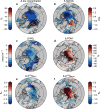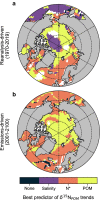Oceanographic and biogeochemical drivers cause divergent trends in the nitrogen isoscape in a changing Arctic Ocean
- PMID: 34628601
- PMCID: PMC8692545
- DOI: 10.1007/s13280-021-01635-6
Oceanographic and biogeochemical drivers cause divergent trends in the nitrogen isoscape in a changing Arctic Ocean
Abstract
Nitrogen stable isotopes (δ15N) are used to study food web and foraging dynamics due to the step-wise enrichment of tissues with increasing trophic level, but they rely on the isoscape baseline that varies markedly in the Arctic due to the interplay between Atlantic- and Pacific-origin waters. Using a hierarchy of simulations with a state-of-the-art ocean-biogeochemical model, we demonstrate that the canonical isotopic gradient of 2-3‰ between the Pacific and Atlantic sectors of the Arctic Ocean has grown to 3-4‰ and will continue to expand under a high emissions climate change scenario by the end of the twenty-first century. δ15N increases in the Pacific-influenced high Arctic due to increased primary production, while Atlantic sector decreases result from the integrated effects of Atlantic inflow and anthropogenic inputs. While these trends will complicate longitudinal food web studies using δ15N, they may aid those focussed on movement as the Arctic isoscape becomes more regionally distinct.
Keywords: Biogeochemistry; Food webs; Primary production; Spatial ecology; Stable isotopes; Trophic position.
© 2021. The Author(s).
Figures






References
-
- Ardyna M, Arrigo KR. Phytoplankton dynamics in a changing Arctic Ocean. Nature Climate Change. 2020;10:892–903. doi: 10.1038/s41558-020-0905-y. - DOI
-
- Aumont O, Ethé C, Tagliabue A, Bopp L, Gehlen M. PISCES-v2: An ocean biogeochemical model for carbon and ecosystem studies. Geoscientific Model Development. 2015;8:2465–2513. doi: 10.5194/gmd-8-2465-2015. - DOI
-
- Bindoff, N.L., W.W.L. Cheung, J.G. Kairo, J. Aristegui, V.A. Guinder, R. Hallberg, N. Hilmi, N. Jiao, et al. 2019. Changing ocean, marine ecosystems, and dependent communities. In IPCC Special Report on the Ocean and Cryosphere in a Changing Climate, ed. H.-O. Portner, C.D. Roberts, V. Masson-Delmotte, P. Zhai, E. Tignor, E. Poloczanska, K. Mintenbeck, A. Alegria, et al., 447–588.
MeSH terms
Substances
Grants and funding
LinkOut - more resources
Full Text Sources

